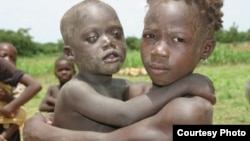October 10 marked World Sight Day. The World Health Organization reported that two-thirds of blind children die within two years following their loss of eyesight.
In addition, the organization said 39 million people worldwide are blind, and another 246 million people live with moderate or severe visual impairments.
Light for the World, a Europe-based N-G-O dedicated to eye health and community-based rehabilitation, is working to demystify some of the causes of blindness, especially in developing nations, where there is a lack of specialized hospitals, eye specialists and medication. In addition, the groups said 80% of all cases of blindness in developing countries can be treated or prevented.
“The main reason for blindness in developing countries is cataract. It’s a form of blindness which can be healed during a very simple operation which lasts only 15 minutes and can restore the eyesight,” explained Gabriel Muller, director of public relations and international alliances for Light For the World.
Muller said that cataracts usually affect older people, but it can also be congenital.
“In sub-Saharan African countries, we do not know the reason why, but it’s coming much earlier than in industrialized countries. Scientists think that it’s a mixture of malnutrition, sanitation, maybe even the [lack of protection from the] sun in these countries, so cataracts develop much earlier,” said Muller.
He added that people living in and near the capitals of cities in sub-Saharan Africa do have access to treatment for cataracts but cannot afford the operation.
However, Light for the World and other humanitarian organizations are working to put into place infrastructures that will enable poor patients and those living in remote areas to receive treatment for their blindness. However, as of now there remains a very big backlog of patients needing treatment for cataracts.
Muller also pointed out that children who are malnourished or who are suffering from infectious diseases are deficient in vitamin A, leading to irreversible loss of eyesight.
“In urgent cases, after famine, and infectious diseases like measles, they need a high dose of vitamin A which is usually part of the national health plan, and distributed by field workers,” explained Muller. He added that in more ordinary cases, workers must go to the communities to educate mothers on how to feed their children the most nutritious foods, such as spinach, green vegetables and mangos which are rich in vitamin A.
In addition to improving the diets of children to avoid blindness, another area in need is increased staffing of specialized medical professionals.
“There is a terrible situation regarding the number of medical specialists compared with the population. In Europe, one opthamologist (eye doctor), has to care for ten thousand people. In sub-Saharan Africa, it is one opthamologist for every one million people, and in remote areas, it is one to every five million persons,” pointed out Muller.
He said the lack of eye specialists in sub-Saharan Africa is causing a very large number of people to become – or remain -- blind unnecessarily.
In addition, the organization said 39 million people worldwide are blind, and another 246 million people live with moderate or severe visual impairments.
Light for the World, a Europe-based N-G-O dedicated to eye health and community-based rehabilitation, is working to demystify some of the causes of blindness, especially in developing nations, where there is a lack of specialized hospitals, eye specialists and medication. In addition, the groups said 80% of all cases of blindness in developing countries can be treated or prevented.
“The main reason for blindness in developing countries is cataract. It’s a form of blindness which can be healed during a very simple operation which lasts only 15 minutes and can restore the eyesight,” explained Gabriel Muller, director of public relations and international alliances for Light For the World.
Muller said that cataracts usually affect older people, but it can also be congenital.
“In sub-Saharan African countries, we do not know the reason why, but it’s coming much earlier than in industrialized countries. Scientists think that it’s a mixture of malnutrition, sanitation, maybe even the [lack of protection from the] sun in these countries, so cataracts develop much earlier,” said Muller.
He added that people living in and near the capitals of cities in sub-Saharan Africa do have access to treatment for cataracts but cannot afford the operation.
However, Light for the World and other humanitarian organizations are working to put into place infrastructures that will enable poor patients and those living in remote areas to receive treatment for their blindness. However, as of now there remains a very big backlog of patients needing treatment for cataracts.
Muller also pointed out that children who are malnourished or who are suffering from infectious diseases are deficient in vitamin A, leading to irreversible loss of eyesight.
“In urgent cases, after famine, and infectious diseases like measles, they need a high dose of vitamin A which is usually part of the national health plan, and distributed by field workers,” explained Muller. He added that in more ordinary cases, workers must go to the communities to educate mothers on how to feed their children the most nutritious foods, such as spinach, green vegetables and mangos which are rich in vitamin A.
In addition to improving the diets of children to avoid blindness, another area in need is increased staffing of specialized medical professionals.
“There is a terrible situation regarding the number of medical specialists compared with the population. In Europe, one opthamologist (eye doctor), has to care for ten thousand people. In sub-Saharan Africa, it is one opthamologist for every one million people, and in remote areas, it is one to every five million persons,” pointed out Muller.
He said the lack of eye specialists in sub-Saharan Africa is causing a very large number of people to become – or remain -- blind unnecessarily.







